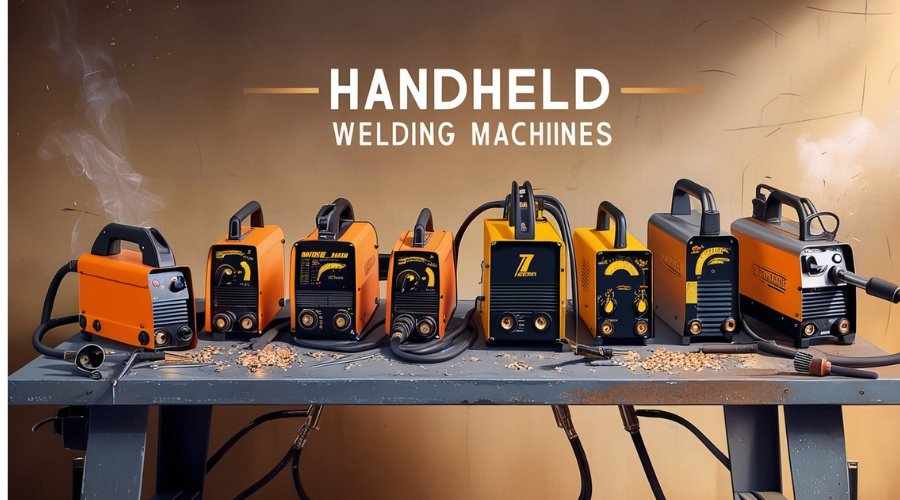.jpg)
Blogs
Handheld Welding Machines: A Complete Guide

Welding is an essential process in construction or manufacturing projects. People at any experience level who need to purchase welding machines should learn basic machine fundamentals to select appropriate tools.
Handheld welding machines are portable and user-friendly tools that attract users to multiple applications. This guide will examine handheld welding machines and their uses and user advantages.
What Exactly Is A Handheld Welding Machine?
The portable welding machine enables users to join metal pieces by applying heat. The electric current from these machines produces an arc effect, melting metal edges until they form a durable bond. Handheld welding machines offer portability since they are convenient tools that excel at welding operations of any size, from minor to medium.
Several Reasons To Select a Portable Welding Machine
- • Users of portable handheld welding machines love their adaptability, user-friendly design, and low cost, which has helped them to become widely used.
- • Choosing handheld welding machines offers various benefits that help to explain their great appeal.
These portable welding tools are ideal for on-site use as their lightweight design and simple transportation help to define them.
- • These welding devices support users with various skill levels because their operation remains straightforward.
- • The handheld machine offers greater affordability in comparison to larger welding systems.
- • These machines are versatile, allowing home maintenance and professional welding projects.
Types of Handheld Welding Machines
The multiple variants of handheld welding machines function optimally with specific materials and certain project conditions. Organizations use the following types of handheld welding machines:
1. Shielded Metal Arc Welding
This process remains the traditional stick welding procedure, also known as manual arc welding. Most workshops with limited funds prefer this welding type because it is affordable. During this procedure, the welder combines metal parts using an electrode. Each electrode serves two functions: rod shape and flux-embedded coating.
The filler material for the joint originates from consumable electrode materials made of steel or stainless steel.
2. Plasma Arc Welding
PAW represents a welding technique that generates welding arcs by applying plasma gas that reaches an ionized state. Plasma and laser welding are different methods within the fusion welding technique. The plasma arc produces such extreme heat that it melts metal pieces to produce precise welded joints.
PAW is an expensive welding device that delivers precise welding outcomes on thin materials. The industrial sector of aerospace and electronics depends on its regular application. Automotive industries.
3. MIG Welding Machine
MIG (Metal Inert Gas) welding produces clear and strong welds through its continuous wire electrode supply while using shielding gas. During the operation, the heat from the electric arc creates a melting effect that turns both materials into a weld pool. MIG welding machines are best used in residential and construction projects.
4. Tungsten Inert Gas Welding
Tungsten inert gas (TIG and gas tungsten arc (GTAW welding are two more methods of handheld welding. A tungsten electrode acts as an electrical conductor to transmit the arc toward the base material. The heat-resilient nature of tungsten allows it to transmit an electrical arc to the work object. The welding area receives protection through an inert argon gas as the welding technician holds the electrode within the torch. Tungsten inert gas (TIG welding allows operation with or without filler material.
Selecting the Ideal Handheld Welding Machine
Several factors, including the kind of metal, the thickness of the material, and the intended working environment, influence your choice of welding machine. These guidelines will assist your decision:
- • Welders should select TIG welding for aluminum and thin metal sheets because it produces the most optimal results. Stick or flux-cored welding provides the best welding solution when performing heavy-duty tasks.
- • MIG welding proves more straightforward for beginners, yet TIG welding appeals better to experienced welders who need exact work.
- • The machines need different power sources since household 110V supports light-duty tasks and 220V enables higher power output.
- • When regular location changes are needed, a portable welding machine requires the selection of lightweight equipment with a compact design.
Prices for handheld welding machines remain lower than industrial models, yet they cost differently depending on their features and brand origin.
Applications of Handheld Welding Machines
Various industrial sectors, as well as multiple construction projects, utilize handheld welding equipment. Some typical applications include:
- • Repairing homes: People use handheld welders to repair their metal furniture, gates, and fences.
- • Automotive repairs: Handheld welding machines fix automobile structures, exhaust tubes, and exterior vehicle panels.
- • Construction: The construction field depends on handheld machines to join structural beams and create railings and supports.
- • Metal Art and Sculptures: making ornaments and artwork out of metal.
- • Industrial Maintenance: These machines repair all industrial-related tools and equipment.
Safety Tips for Using a Handheld Welding Machine
Safety becomes vital when performing welding tasks because welding requires elevated temperature levels with electrical streams. The following safety rules must always be followed:
- • Protective equipment, including a welding helmet, protective gloves, and clothing, must be your first choice to block out sparks and ultraviolet light.
- • Use well-ventilated spaces while welding because inhaling its smoke can lead to harm. Ensure proper ventilation.
- • Inspect all equipment components, including cables with electrodes and gas connections, before the commencement of work.
- • Your workspace should have a mounted fire extinguisher present because welding nearby flammable materials brings potential fire dangers.
- • Always read the manual to access safe operation guidelines for each welding machine per manufacturer instructions.
Maintenance Tips for Handheld Welding Machines
The combination of regular maintenance allows your welding machine to operate effectively while extending its total lifespan. Follow these simple maintenance tips:
- • Regular nozzle cleaning while removing electrode spatters enables the arc to operate smoothly.
- • Poor performance and safety risks may appear because of loose or damaged cables in the system.
- • Keeping your machine in a dry environment will prevent both rust formation and electrical system destruction.
- • The replacement of worn electrodes wir, es, and tips is necessary when they reach their end of service.
Conclusion
Handheld welding machines are essential for several work projects. They are also a good alternative for home renovators, constructors, and professionals. As mentioned in this blog, you can choose from numerous types of welding equipment for your work needs.
